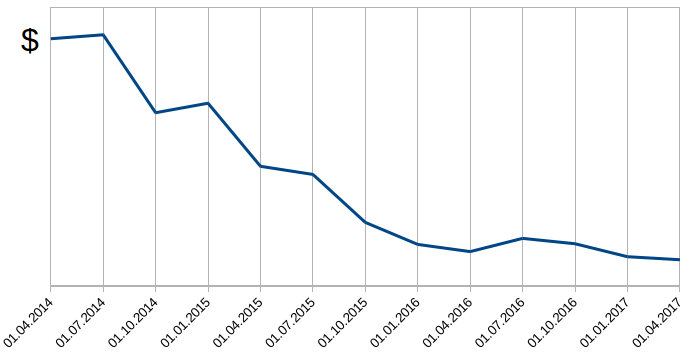We write our book again
4 years have passed since the publication of “We are writing our book” and the second edition of the book about Boost and C ++ has been published. It's time to release the second edition of the publication!
In this article, I will share information about what was left behind the previous article:

')
Your fees depend on sales, and sales are very dependent on many factors:
This is approximately what your earnings look like over time:

Roughly speaking, in order to get as much as a novice developer at the expense of fees, you need to produce about six books in 4 years.
Choose a topic you want to tell the world. Look on the Internet for books on similar topics, and then figure out how to differ from all the others.
An additional advantage would be if your distinctive feature is easy to update in new editions. For example, if in the first edition it was about how the Boost libraries relate to C ++ 11, then in the second edition you can expand the topic and describe how the Boost libraries relate to the new C ++ standards (C ++ 14, C ++ 17 and C + +20)

It’s just fun to read, of course, but if you can change and launch an example from a book in two clicks, try to fit it to your needs or even like “poking it with a stick” it will be much more pleasant to read.
The less gestures a reader needs, the better. My ideal option is a site with online compilation ( mini instructions on how to make your site ).
The release of the second edition differs little from the first. Count on half the time (if there are many additions, this can result in a twice more vigorous pace of work).

New topics that do not pull on a full chapter should be carefully integrated into old chapters.
You will also have to re-read, supplement and improve several times the old chapters.
Outdated chapters can and should be removed, but this results in an unexpectedly large amount of work. So, for example, if you described the bind (...) function, and more recently, its use is not considered a good form, then it makes sense to shorten the chapters describing it as much as possible, and try not to use it in the rest of the book. This translates into processing a decent piece of source code and text changes. Type 3-4 such functions, and you will have to recycle half of the book.
The process of technical review and proofreading is the same as for the first edition. With large changes, review and recheck will be the whole book.
As in the case of the first edition, you are paid “lifting” when writing 50%, 75% and 100% of the material. The size of the "lifting" is determined from the preliminary plan, which you send to the publisher before starting work. In terms of a list of chapters for modification, deletion and addition. Based on the amount of work, your "lifting" can be up to the size of the "lifting" of the first edition.

The publisher will certainly advertise your book on their sites. But greater profit brings advertising on thematic sites.
Look at the official site, the technology you describe. As a rule, there is a bibliography page, and in order to add a link there it is sometimes just a single letter or a pull request. In the case of Boost, the page looks like this .
Posting sources on github is also useful: some users search by tag in github. Add Readme.md with a link to your book and to the site with online examples, correctly tag and readers will reach for you. Pay attention to the name of your repository. It should be simple! When I removed the ISBN from the name, over the month the number of likes increased by a third.
Be sure to test your code! Use all available methods, including sanitizers, code coverage, and CI, since all is available on Github. The better your code will be, and the more green dice the Readme will have, the more readers will have more confidence in your book.

If your book is popular, then other publishers may want to buy translation rights. From one such transfer right you will receive about $ 200 + paper version of the translated book. She can brag about in social networks and other methods to increase the CSW. It is especially nice to brag about translations into Korean - the book is twice as thick in this language.
Last time, we managed to get permission from the publisher to openly publish introductions to each topic from the book. With the second edition it turned out to repeat this feat and place all the materials on the online compilation site.
The next step is to knock out the sources of the texts of the first edition and the right to open them.
In this article, I will share information about what was left behind the previous article:

')
- Is it possible to live on the fees from the book
- How to get people interested in your book
- How to make examples clearer and more interactive
- What distinguishes the release of the second edition, from writing the first
- A couple of simple tips to promote.
- Translation of the book into other languages
About money
Is it possible to live on a fee from one book
Not.
Your fees depend on sales, and sales are very dependent on many factors:
- Year of publication - the older your book is, the less it is bought.
- The economic situation - if a crisis suddenly breaks out (as was the case in 2014), then people will start buying less by almost an order of magnitude
- The appearance of publications of competitors on the same subject
This is approximately what your earnings look like over time:

Roughly speaking, in order to get as much as a novice developer at the expense of fees, you need to produce about six books in 4 years.
What to write about
Choose a topic you want to tell the world. Look on the Internet for books on similar topics, and then figure out how to differ from all the others.
Banality
It is good content that allows you to sink less for money, over time. The more interesting and unique your ideas are - the more readers will advise your book to their friends and the longer the book will be relevant.
An additional advantage would be if your distinctive feature is easy to update in new editions. For example, if in the first edition it was about how the Boost libraries relate to C ++ 11, then in the second edition you can expand the topic and describe how the Boost libraries relate to the new C ++ standards (C ++ 14, C ++ 17 and C + +20)
Interactive

It’s just fun to read, of course, but if you can change and launch an example from a book in two clicks, try to fit it to your needs or even like “poking it with a stick” it will be much more pleasant to read.
The less gestures a reader needs, the better. My ideal option is a site with online compilation ( mini instructions on how to make your site ).
1.0 vs 2.0
The release of the second edition differs little from the first. Count on half the time (if there are many additions, this can result in a twice more vigorous pace of work).

New topics that do not pull on a full chapter should be carefully integrated into old chapters.
You will also have to re-read, supplement and improve several times the old chapters.
Outdated chapters can and should be removed, but this results in an unexpectedly large amount of work. So, for example, if you described the bind (...) function, and more recently, its use is not considered a good form, then it makes sense to shorten the chapters describing it as much as possible, and try not to use it in the rest of the book. This translates into processing a decent piece of source code and text changes. Type 3-4 such functions, and you will have to recycle half of the book.
The process of technical review and proofreading is the same as for the first edition. With large changes, review and recheck will be the whole book.
As in the case of the first edition, you are paid “lifting” when writing 50%, 75% and 100% of the material. The size of the "lifting" is determined from the preliminary plan, which you send to the publisher before starting work. In terms of a list of chapters for modification, deletion and addition. Based on the amount of work, your "lifting" can be up to the size of the "lifting" of the first edition.
PR

The publisher will certainly advertise your book on their sites. But greater profit brings advertising on thematic sites.
Look at the official site, the technology you describe. As a rule, there is a bibliography page, and in order to add a link there it is sometimes just a single letter or a pull request. In the case of Boost, the page looks like this .
Posting sources on github is also useful: some users search by tag in github. Add Readme.md with a link to your book and to the site with online examples, correctly tag and readers will reach for you. Pay attention to the name of your repository. It should be simple! When I removed the ISBN from the name, over the month the number of likes increased by a third.
Be sure to test your code! Use all available methods, including sanitizers, code coverage, and CI, since all is available on Github. The better your code will be, and the more green dice the Readme will have, the more readers will have more confidence in your book.
When overzealous ...
There were so many tests for examples from the book that they began to catch errors from Boost. For example, one of the tests caught the error in Boost.ASIO.
Translations

If your book is popular, then other publishers may want to buy translation rights. From one such transfer right you will receive about $ 200 + paper version of the translated book. She can brag about in social networks and other methods to increase the CSW. It is especially nice to brag about translations into Korean - the book is twice as thick in this language.
What are the fees for translation sales, such as Chinese
0%. Life is pain!
Instead of totals
Last time, we managed to get permission from the publisher to openly publish introductions to each topic from the book. With the second edition it turned out to repeat this feat and place all the materials on the online compilation site.
The next step is to knock out the sources of the texts of the first edition and the right to open them.
Source: https://habr.com/ru/post/338946/
All Articles